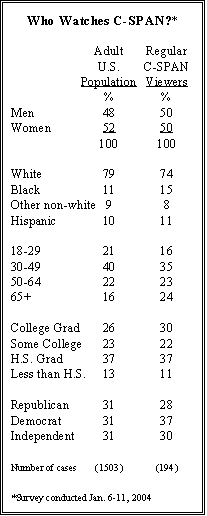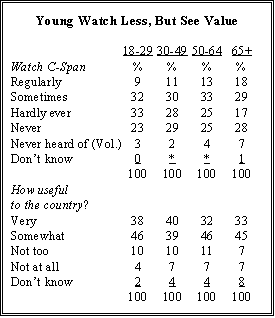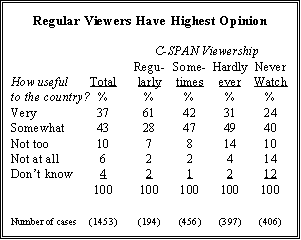 A quarter century after its creation, C-SPAN has a positive image with the general public and attracts a highly loyal audience: Six-in-ten regular viewers (61%) find it very useful and a significantly higher percentage (74%) say they would miss it if it were no longer available.
A quarter century after its creation, C-SPAN has a positive image with the general public and attracts a highly loyal audience: Six-in-ten regular viewers (61%) find it very useful and a significantly higher percentage (74%) say they would miss it if it were no longer available.
Pew Research Center surveys have shown that as many as 12% of Americans are regular C-SPAN viewers. That figure comes from a January 2004 survey, in which another 31% say they sometimes watch C-SPAN. In that survey, C-SPAN was the only news organization respondents were asked about. When viewership for C-SPAN is measured along with other news outlets, such as major cable news networks, network evening news, and newspapers, fewer Americans report watching C-SPAN. In an April 2002 survey, which used this format, 5% said they regularly watched C-SPAN and 18% said they sometimes watched it. (The broader survey, covering a wide range of news sources, will be updated later this year).
Despite the varying estimates of the overall size of C-SPAN viewership, it is clear that the audience is broad based. The composition of the C-SPAN audience in terms of race, gender and education is similar to that of all adults. As is the case with most news sources, the C-SPAN audience is somewhat older than the general public roughly a quarter of the audience (24%) is age 65 and older, compared with 16% of the public overall. The C-SPAN audience also includes slightly more Democrats than Republicans (37% vs. 28%). The general public is evenly divided politically (31% each).
Most View C-SPAN As Useful
Despite generational differences in viewership, young people express just as favorable opinions of C-SPAN as do older Americans. Fully 39% of Americans under age 50 (and 38% of those under age 30) say it is very useful for the country to have C-SPAN show Congress at work and provide other government-related programming; 32% of those age 50 and older express that view.
 Most Americans who watch C-SPAN say they would miss it if it were no longer available. Roughly three-quarters of those who regularly watch the network say they would miss it a lot (38%) or some (36%), and about half of those who sometimes watch also say they would miss the network.
Most Americans who watch C-SPAN say they would miss it if it were no longer available. Roughly three-quarters of those who regularly watch the network say they would miss it a lot (38%) or some (36%), and about half of those who sometimes watch also say they would miss the network.
While the core C-SPAN audience is most likely to see the network’s value to the nation, most people who never watch C-SPAN still hold a high opinion of the network. Roughly two-thirds of those who never watch say the network is very (24%) or somewhat (40%) useful for the country. Virtually everyone who regularly watches C-SPAN holds this view, with fully 61% saying the network is very useful.
Relatively few Americans know that C-SPAN is paid for through fees from cable and satellite companies. In fact, nearly as many incorrectly believe that the network is funded by the federal government (10%) as say the network runs independently based on cable and satellite licensing fees (12%).
 Regular C-SPAN viewers are somewhat more informed about the network’s funding sources, but still only 21% of regular viewers know how C-SPAN is funded.
Regular C-SPAN viewers are somewhat more informed about the network’s funding sources, but still only 21% of regular viewers know how C-SPAN is funded.
About the Survey
Results for the survey are based on telephone interviews conducted under the direction of Princeton Survey Research Associates among a nationwide sample of 1,503 adults, 18 years of age or older, during the period January 6-11, 2004. Based on the total sample, one can say with 95% confidence that the error attributable to sampling and other random effects is plus or minus 3 percentage points.
In addition to sampling error, one should bear in mind that question wording and practical difficulties in conducting surveys can introduce error or bias into the findings of opinion polls.


